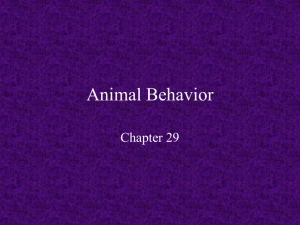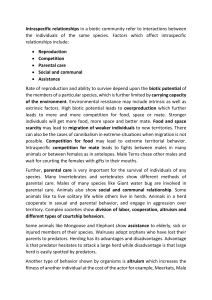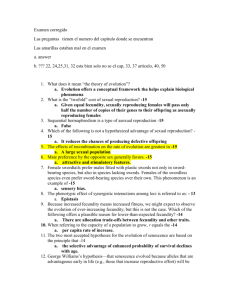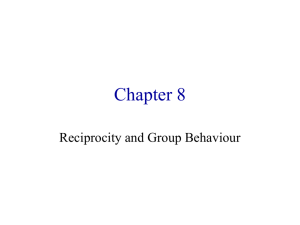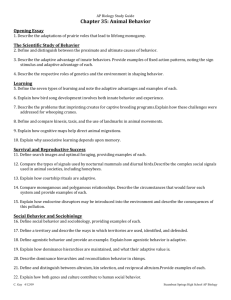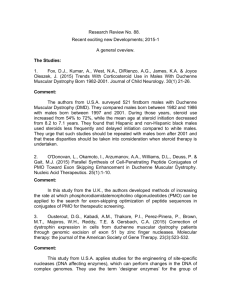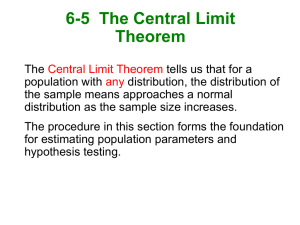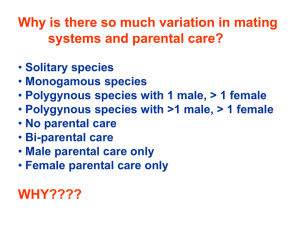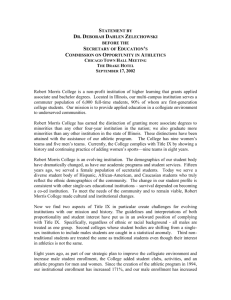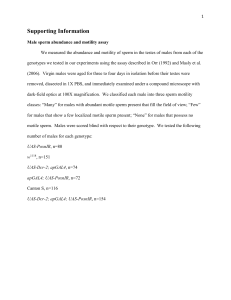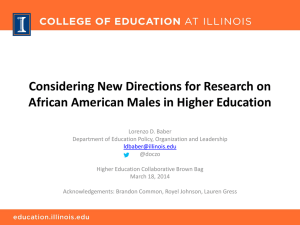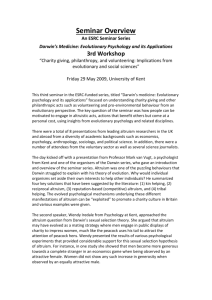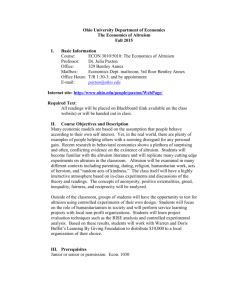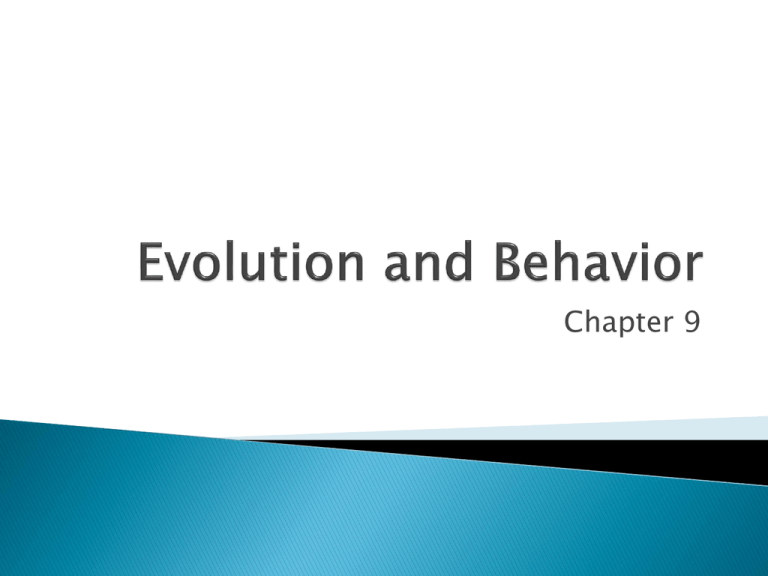
Chapter 9
Behavior is all of
the actions of an
organism during its
life time.
These are adaptive
traits that have an
evolutionary
history.
Proximate Causation◦ Genetic basis
◦ Physiological basis
◦ Developmental basis
Ultimate Causation◦ Evolutionary basis
◦ Phylogenetic basis
Proximate – taste
receptors, ingestion of
ice cream, digestion of
ice cream, pleasure
activation in brain.
Ultimate – Why is a
preference for sugary
and fat rich foods an
adaptive behavior?
How has this
preference increased
survivorship and
reproduction in the
past?
Instinct – Behavior that is not learned.
Performed first time well with no experience.
Some instincts are Fixed Action Patterns.
◦ These are triggered by a specific Sign stimulus
◦ Go to completion once started
◦ Even if behavior is inappropriate
Mating signal in black birds
White shell removal by gulls
A) not subject to the normal evolutionary
process because it involves a neurological
system.
B) a trait that can satisfy the three conditions
required for evolution by natural selection.
C) something that is too complex to arise
through natural selection.
D) Both b) and c) are correct.
E) All of the above are correct.
A) She’s trying to get nutrition from
any source she can.
B) She’s using the beer can as part of the nest border
to protect the eggs.
C) She’s a first-time mother and is in the process of
learning the difference between eggs and noneggs.
D) She’s a silly goose.
E) She’s exhibiting a fixed action pattern that directs
her to retrieve any item that even vaguely
resembles an egg.
A) yes
B) no
Behavior changes with
experience
◦ May not be programmed
◦ Can learn new
associations, problem
solve, or how to run a
maze, etc.
◦ This can result in more
rapid changes than the
modification of an
instinct by natural
selection
◦ Human society changing
quickly with our ability to
learn and develop new
ideas
Animals learn where
home is, who their
neighbors are, the odor of
their mate, migration
routes, who is dominant,
local song dialect, etc.
Many different contexts
and types of learning.
Programmed
learning
Learning occurs
in a very specific
way, often
during a set
critical period for
that learning
Rare examples of specific
gene – single behavior
Rare that 100% of
behavior is learned
Can’t learn to walk
unless have the anatomy
to do so
White crowned sparrows
inherit a template for
their song, learn a
dialect, and perfect it
through practice and
listening to own song
Programmed learning
◦ Children go through similar stages when learning to
talk and they practice to improve sounds and
sentences.
Learn the sounds of one language and lose ability to
hear unique sounds of different languages
More difficult to learn a new language when you are
older than when you are a child
A problem is solved through trial and error or
seeing the problem and figuring out the
solution through a thought process.
This is also a behavior that is not only found
in humans.
Examples: Japanese Snow Monkeys
◦ Chimpanzees
◦ Woodpecker finches
◦ Octopus
http://www.youtube.com/watch?feature=play
er_detailpage&v=9kuAiuXezIU
Cooperation – mutual assistance between 2
or more individuals
Selfishness – Behavior that benefits the
individual doing the behavior
Altruism – Behavior that benefits another at
the detriment of oneself
Individuals help each
other care for young
or hunt
Individuals support
each other to gain
social status
Many contexts
Cooperation can appear to
be pure altruism, but it is
based on a knowledge that
this individual will return the
favor in the future.
Really = Reciprocal Altruism
Altruism in the context of helping
related individuals survive and pass on
shared genes.
A) aggression between sexes increases the survival
and reproduction of the fittest individuals.
B) companionship is advantageous to animals
because in the future they can recognize those
companions that helped them in the past and
can request help from them once again.
C) genes are more likely to persist within a
population when they cause behaviors that
assist other animals who share those genes.
D) companionship is advantageous to animals
because in the future they can recognize those
companions that helped them in the past and
can provide help to those individuals.
E) aggression within sexes increases the survival and
reproduction of the fittest individuals.
Exceptions
exist and
help us
understand
why one
sex is
choosier
than
another.
With high reliability
of paternity, you
can see males
investing more than
females in the
production and care
of offspring
Mate
guarding
Monogamy
◦ 1 male + 1 female
◦ Monomorphic
◦ Shared parental care
Polygamy
◦ 1 male + multiple
females or
◦ 1 female + multiple
males
◦ Dimorphic
◦ One sex has most of
the parental care or
there is no parental
care.
Symbolic Communication
A) Males are more brightly colored.
B) Males produce motile gametes.
C) Males are larger.
D) Males are more aggressive.
E) All of the above are correct.
A) securing essential nutrients.
B) minimizing energy expended.
C) maximizing energy gained.
D) minimizing the risk of predation during
foraging and feeding.
E) maximizing the size of each prey item.
A) less discriminating
B) more competitive
C) more exhaustive
D) more discriminating
E) less interested
Evolution has
favored efficient
behavior such that
an animal
minimizes cost and
maximizes the
benefits.
Sometimes what
has driven the
evolution is not
just energy, even
when considering
foraging.

